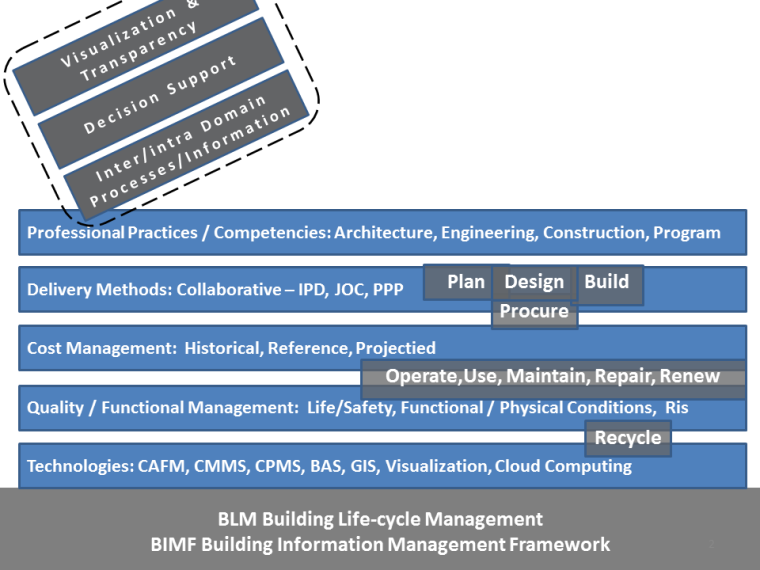BIM & LEAN / COLLABORATIVE CONSTRUCTION DELIVERY – If only we could get there!
BEYOND DESIGN, BIM BEGINS WITH 10 STEPS…
- Owner competency & leadership
- Life-cycle asset management philosophy
- Best value procurement
- Collaborative construction delivery methods (IPD, JOC, …)
- Mutual trust & respect
- Common terms, definitions, and data architectures….all in plain English
- Shared risk/reward
- Monitoring via key performance indicators (KPIs)
- Ongoing education, training, & awareness buildling
- Continuous improvement
Building Information Modelling (BIM) is the integration of disparate competencies, business processes, and technologies to accomplish the efficient life-cycle management of the built environment.
Per the above definition, BIM has not moved from theory to reality to any significant extent. Improving facility and infrastructure construction, management, operations, and sustainability is indeed possible, if Owners provide competent leadership.
Owners must also recognize the value of collaboration, LEAN management methods, and information-based decision-making.
The fundamental way in which Owners, Architects, Engineers, Contractors, Building Users, and Oversight Groups interact must change. The issue is not, nor has ever been, shortcomings in technology. The vacuum is one of lack of change management skills and lack of overall asset life-cycle management competency.
Asset life-cycle management, as demonstrated in the figure below, requires an integration of business areas and competencies.

The primary driver is actually the construction delivery method. It is the construction delivery method that contractually defines roles, responsibilities, timelines, deliverables, relationships, and sets the tone for a project from day one. The construction delivery method can actually REQUIRE COLLABORATION of all participants, right down to the terms, definitions, and information used.
Thus a collaborative construction delivery CONTRACT and its associated OPERATIONS or EXECUTION MANUAL are the detailed road map to completed a significantly higher percentage (90%+) of quality renovation, repair, and construction projects on-time and on-budget, and to the satisfaction of ALL participants.
Collaborative construction delivery methods such as Integrated Project Delivery, IPD for major new construction, and Job Order Contracting, JOC, for renovation, repair, maintenance, and minor new construction aren’t new. The both have proven track records spanning decades.


So, why isn’t everyone using collaborative construction delivery methods, and why aren’t 90% of projects delivered on-time and on-budget? The answer has already been noted… owners are providing the necessary competent leadership, and many players are satisfied with the status quo.
It’s not simply a a learning curve issues, it’s a culture change. The multi-party nature, required financial transparency, and sharing of risk and reward is a definite hurdle for many. Some current owners, contractors, and AE’s, quite simply, won’t be able to make the required transition.
Would it not be nice to stop focusing upon pretty 3D pictures, dated IWMS systems, and other technologies that dictate process and/or embed antagonistic workflows? As stated previously, technology isn’t the solution, it can however be a crutch, and a problem… if it prevents us from asking the right questions… and dealing with positive change.
















